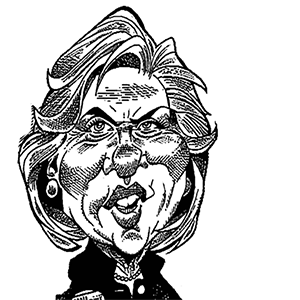Links between gender stereotypes and American patriotism date from the Cold War − but weren’t true then either
Published in Political News
In 1959, at the opening of the American National Exhibition in Moscow, in front of a model American kitchen full of appliances, Vice President Richard Nixon and Soviet Premier Nikita Khrushchev sparred over the advantages of the two countries’ economic systems. Nixon pointed to the dishwasher on display: “In America, we like to make life easier for women.”
Unimpressed, Khrushchev retorted, “Your capitalistic attitude toward women does not occur under Communism.”
Nixon doubled down on his vision of the social role of women: “What we want to do, is make life easier for our housewives.”
The practice of linking traditional gender roles to American values has continued, and it was visible in the 2024 U.S. presidential election.
Vice President-elect JD Vance described the ideal American family as one in which the woman’s primary role is as a stay-at-home mother. He also said Kamala Harris’ lack of biological children made her unsuitable to hold a national leadership role.
As a scholar of American society and culture, I have found that this conflation of domesticity, patriotism and Americanness can be traced back to the 1950s. During those early years of the Cold War, the traditional nuclear family was perceived as crucial to the nation’s security. It also served to illustrate the superiority of the democratic capitalist model.
America’s leaders promoted the idea that the nation could be successful in its fight against communism only if women stayed in the home, protected it from within and raised the next generation to be loyal to American ideals.
Women were central to Cold War-era international debates about the two competing political and economic systems. On both sides of the Iron Curtain, governments used references to women’s happiness as proof their respective models provided good lives for their population, even though reality was often different.
Official Soviet Union propaganda praised the political commitment and virtue of communist women, who could occupy any type of position in the workforce, from physical labor to leadership roles.
In the U.S., pundits and politicians presented American women as primarily homemakers who found purpose in life by embracing their biological destiny. In a 1956 address to the National Council of Catholic Women, FBI Director J. Edgar Hoover, perhaps the country’s most famous anti-communist crusader at the time, declared: “There are no careers so important as those of homemaker and mother.”
Although American women had been politically active in the past, their social and political movements were subsumed under the anti-communist priorities of the Cold War. Groups of white middle- and upper-class housewives became enthusiastic anti-commmunist crusaders. They hosted teas, wrote letters and petitions, and spoke at women’s clubs about the dangers of communists lurking in their communities.
These women’s commitment to domesticity simultaneously engaged them politically and bound them to their role as homemakers.
The image of the happy American housewife was also central to American public diplomacy efforts. One of the longest-lived publications of the United States Information Agency was Amerika, a Russian-language magazine showcasing everyday life in the U.S. to Soviet readers.
From 1945 until 1994, Amerika’s stories depicted the United States as a country that protected the sanctity of family life, and where women lived abundant, comfortable lives caring for their families, unlike their Soviet counterparts.
Consumerism and domesticity were interlinked in both U.S. public diplomacy efforts and in the media as manifestations of the ideal American way of life.
American media pushed the same message for readers at home. Publications such as Better Homes and Gardens, Good Housekeeping, Mademoiselle, Vogue, Women’s Day and the Ladies’ Home Journal celebrated the joys of consumption.
These magazines advertised consumer goods, from appliances to cosmetics, while educating their readers about the dangers communism posed to cherished American values and institutions, including churches and the family.
Opinion articles, advice columns and letters from the wives of U.S. officials stationed in the USSR contrasted the privileged lives of American homemakers with those of Soviet women who did not enjoy any lavish consumer goods and had to work just like men because their governments sent them to work in factories, collective farms or the army.
Americans were urged to view the home and the family as the ultimate haven of safety in the 1950s. There was widespread anxiety about another economic depression and rapidly changing technologies, nuclear war with the USSR and communist infiltration.
The ideal American life depicted by the media was a life of white, middle-class, heterosexual domesticity. Returning veterans had found new jobs in the booming economy, which validated their identity as providers. But the regimented corporate work environment discouraged performances of masculinity rooted in combativeness, strength or aggressiveness. The rugged frontiersmen of yesteryear were now docile employees in gray flannel suits.
The traditional family, with women and children as subordinates, became the mythical place where old-fashioned American masculinity could still thrive.
In fact, the realities of employment in 1950s America were quite complex. Working-class women, white and Black, had always had to work outside the home. During the Great Depression, many middle-class American women had to take jobs to support their families. During World War II, women did men’s work and were praised for doing so.
Yet nearly all the jobs filled by women returned to men after the war. What was left were the so-called pink-collar jobs, largely viewed by society as temporary occupations for girls waiting to get married.
In 1953 one-fourth of all married women were in the labor force. Between 1948 and 1958, the number of working mothers increased by 50%. Of these, 7.5 million had children under 18. These women worked in jobs in addition to being fully responsible for running their homes, were paid only a fraction of men’s salaries, had very limited child care options, and enjoyed no job security. A report of the 1960 White House Conference on Children and Youth revealed that nonwhite female workers made less than half the income of white female workers.
Overall, Americans in the 1950s felt ambivalent about working women and the impact women’s work outside the home may have had on families. Yet, many who may have dreamed of being housewives could not afford to do so. Some sought employment not because they were unpatriotic but to bolster the family finances. Others simply had no choice.
The idealized image of 1950s American women who found their fulfillment in life in their roles as mothers and wives is a construct that emerged out of the need to distinguish the American capitalist system from the Soviet communist one. Although it was an ideal that most Americans at the time aspired to, it did not reflect the broad spectrum of lives and work arrangements of American families at the time.
This article is republished from The Conversation, a nonprofit, independent news organization bringing you facts and trustworthy analysis to help you make sense of our complex world. It was written by: Oana Godeanu-Kenworthy, Miami University
Read more:
Genetic testing cannot reveal the gender of your baby − two genetic counselors explain the complexities of sex and gender
How ‘complementarianism’ – the belief that God assigned specific gender roles – became part of evangelical doctrine
One’s a Hugh Grant thriller, one’s a hot-mess reality show – and both center on stereotypes about Mormon women
Oana Godeanu-Kenworthy received funding from the Fulbright Commission and The Library of Congress.
































































Comments